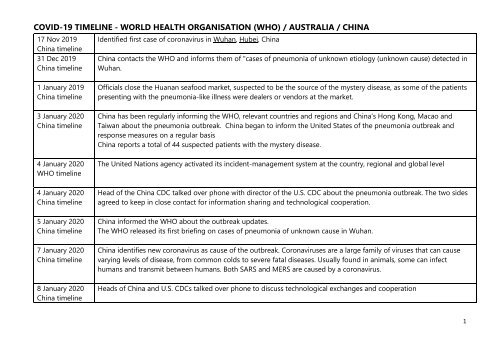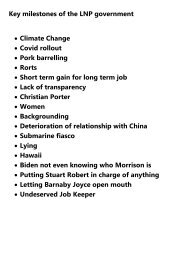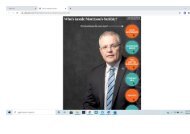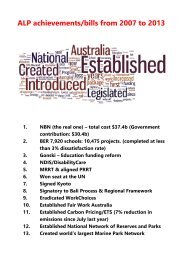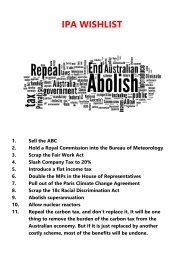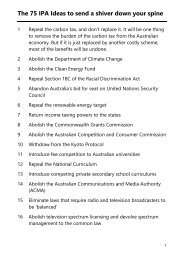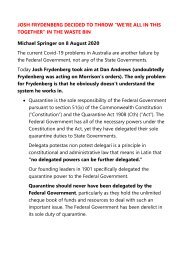Covid19 timeline WHO China Aust
Create successful ePaper yourself
Turn your PDF publications into a flip-book with our unique Google optimized e-Paper software.
COVID-19 TIMELINE - WORLD HEALTH ORGANISATION (<strong>WHO</strong>) / AUSTRALIA / CHINA<br />
17 Nov 2019<br />
<strong>China</strong> <strong>timeline</strong><br />
31 Dec 2019<br />
<strong>China</strong> <strong>timeline</strong><br />
Identified first case of coronavirus in Wuhan, Hubei, <strong>China</strong><br />
<strong>China</strong> contacts the <strong>WHO</strong> and informs them of "cases of pneumonia of unknown etiology (unknown cause) detected in<br />
Wuhan.<br />
1 January 2019<br />
<strong>China</strong> <strong>timeline</strong><br />
3 January 2020<br />
<strong>China</strong> <strong>timeline</strong><br />
4 January 2020<br />
<strong>WHO</strong> <strong>timeline</strong><br />
4 January 2020<br />
<strong>China</strong> <strong>timeline</strong><br />
5 January 2020<br />
<strong>China</strong> <strong>timeline</strong><br />
7 January 2020<br />
<strong>China</strong> <strong>timeline</strong><br />
8 January 2020<br />
<strong>China</strong> <strong>timeline</strong><br />
Officials close the Huanan seafood market, suspected to be the source of the mystery disease, as some of the patients<br />
presenting with the pneumonia-like illness were dealers or vendors at the market.<br />
<strong>China</strong> has been regularly informing the <strong>WHO</strong>, relevant countries and regions and <strong>China</strong>'s Hong Kong, Macao and<br />
Taiwan about the pneumonia outbreak. <strong>China</strong> began to inform the United States of the pneumonia outbreak and<br />
response measures on a regular basis<br />
<strong>China</strong> reports a total of 44 suspected patients with the mystery disease.<br />
The United Nations agency activated its incident-management system at the country, regional and global level<br />
Head of the <strong>China</strong> CDC talked over phone with director of the U.S. CDC about the pneumonia outbreak. The two sides<br />
agreed to keep in close contact for information sharing and technological cooperation.<br />
<strong>China</strong> informed the <strong>WHO</strong> about the outbreak updates.<br />
The <strong>WHO</strong> released its first briefing on cases of pneumonia of unknown cause in Wuhan.<br />
<strong>China</strong> identifies new coronavirus as cause of the outbreak. Coronaviruses are a large family of viruses that can cause<br />
varying levels of disease, from common colds to severe fatal diseases. Usually found in animals, some can infect<br />
humans and transmit between humans. Both SARS and MERS are caused by a coronavirus.<br />
Heads of <strong>China</strong> and U.S. CDCs talked over phone to discuss technological exchanges and cooperation<br />
1
COVID-19 TIMELINE - WORLD HEALTH ORGANISATION (<strong>WHO</strong>) / AUSTRALIA / CHINA<br />
9 January 2020<br />
<strong>China</strong> <strong>timeline</strong><br />
<strong>China</strong> informed the <strong>WHO</strong> about the epidemic, sharing with the <strong>WHO</strong> the initial progress in determining the cause of<br />
the viral pneumonia in Wuhan. The <strong>WHO</strong> released on its website a statement regarding a cluster of pneumonia cases<br />
in Wuhan, saying that preliminary identification of a novel coronavirus in a short period of time is a notable<br />
achievement. <strong>China</strong> reports first death linked to the new coronavirus, 2019-nCoV. A 61-year-old male admitted to<br />
hospital in Wuhan with several underlying medical conditions. Apart from respiratory failure and severe pneumonia, the<br />
patient also suffered from abdominal tumors and chronic liver disease.<br />
10 January 2020<br />
<strong>China</strong> <strong>timeline</strong><br />
12 January 2020<br />
<strong>China</strong> <strong>timeline</strong><br />
13 January 2020<br />
<strong>China</strong> <strong>timeline</strong><br />
Head of the NHC Ma Xiaowei talked over phone with <strong>WHO</strong> Director-General Tedros Adhanom Ghebreyesus about the<br />
epidemic response.<br />
Head of <strong>China</strong> CDC exchanged information over phone with <strong>WHO</strong> Director-General Tedros Adhanom Ghebreyesus.<br />
The <strong>China</strong> CDC shared with the <strong>WHO</strong> the specific primers and probes for detecting the novel coronavirus.<br />
The Wuhan Municipal Health Commission changed the name of "viral pneumonia of unknown cause" to "pneumonia<br />
caused by the novel coronavirus" for the first time in a briefing.<br />
The <strong>China</strong> CDC, the CAMS and the WIV under the Chinese Academy of Sciences (CAS), as designated agencies of the<br />
NHC, submitted to the <strong>WHO</strong> the genome sequence of the novel coronavirus (2019-nCoV), which was published by the<br />
Global Initiative on Sharing All Influenza Data (GISAID) and shared globally.<br />
The NHC shared with the <strong>WHO</strong> about information on the genome sequence of the novel coronavirus.<br />
<strong>China</strong> shares the genetic sequence of the novel coronavirus, helping countries in testing and tracing any potentially<br />
infected people.<br />
The NHC held a meeting to instruct Wuhan authorities to further strengthen social management measures and body<br />
temperature monitoring of people at ports and stations, as well as reduce crowd gathering.<br />
The <strong>WHO</strong> issued on its official website a statement on the discovery of the novel coronavirus cases in Thailand,<br />
pointing out that <strong>China</strong>'s sharing of the genome sequence enabled more countries to quickly diagnose patients.<br />
2
COVID-19 TIMELINE - WORLD HEALTH ORGANISATION (<strong>WHO</strong>) / AUSTRALIA / CHINA<br />
15 January 2020<br />
<strong>China</strong> <strong>timeline</strong><br />
The NHC unveiled the first version of guidelines on diagnosis and treatment for pneumonia caused by novel<br />
coronavirus, along with the guidelines on prevention and control measures. <strong>China</strong> reports second death linked to 2019-<br />
nCoV. The patient was a 69-year-old male with severe myocarditis, abnormal renal function, and severe damage to<br />
multiple organ functions.<br />
16 January 2020<br />
<strong>China</strong> <strong>timeline</strong><br />
18 January 2020<br />
<strong>China</strong> <strong>timeline</strong><br />
19 January<br />
2020<br />
<strong>Aust</strong> <strong>timeline</strong><br />
19 January 2020<br />
<strong>China</strong> <strong>timeline</strong><br />
20 January 2020<br />
<strong>China</strong> <strong>timeline</strong><br />
Foreign journalists asked about the epidemic for the first time at a press conference held by the Chinese foreign<br />
ministry in Beijing. Foreign ministry spokesperson said that <strong>China</strong> has timely informed the <strong>WHO</strong> and other international<br />
organizations of the outbreak and kept close communication with them.<br />
The NHC released the second version of guidelines on the diagnosis and treatment for the pneumonia caused by the<br />
novel coronavirus.<br />
Chinese citizen who arrived in <strong>Aust</strong>ralia from Guangzhou on 19 January diagnosed with virus<br />
The <strong>China</strong> CDC communicated with the U.S. CDC on epidemic prevention and control.<br />
Chinese authorities report a spike in 2019-nCoV cases, including first confirmed cases in Shenzhen (1 case) and Beijing<br />
(2 cases), bringing the total to 204 confirmed cases. They also report a third death linked to the new coronavirus.<br />
The NHC released a statement to classify the novel coronavirus pneumonia as a category B infectious disease under the<br />
law on prevention and control of infectious diseases, but take preventive and control measures of category A infectious<br />
diseases; the novel coronavirus pneumonia was put under quarantinable infectious disease management according to<br />
the Frontier Health and Quarantine Law.<br />
-- The NHC published the second version of guidelines on the prevention and control of the novel coronavirus<br />
pneumonia.<br />
3
COVID-19 TIMELINE - WORLD HEALTH ORGANISATION (<strong>WHO</strong>) / AUSTRALIA / CHINA<br />
21 January 2020<br />
<strong>WHO</strong> <strong>timeline</strong><br />
<strong>WHO</strong> confirms human-to-human transmission of the virus. The total number of cases is now 222, including infections<br />
among health-care workers. Chinese authorities have also reported a fourth death.<br />
21 January 2020<br />
<strong>China</strong> <strong>timeline</strong><br />
The NHC started to update via its official website and its new media platform the epidemic information of the previous<br />
day on a daily basis. It had updated 71 times by March 31. Starting on Feb. 3, the English official website of the NHC<br />
started releasing epidemic information simultaneously, updating the data for 58 times by March 31.<br />
A foreign ministry spokesperson said <strong>China</strong> will, upon invitation from the <strong>WHO</strong>, send representatives to attend an<br />
International Health Regulations (IHR) Emergency Committee meeting.<br />
The <strong>WHO</strong> published a statement on its official website saying on Jan. 20-21, a <strong>WHO</strong> delegation conducted a field visit<br />
to Wuhan to learn about the response to 2019 novel coronavirus (2019-nCoV) and visited the Wuhan Tianhe Airport,<br />
Zhongnan hospital, Hubei provincial CDC.<br />
Chinese experts shared with Gauden Galea, the <strong>WHO</strong> Representative in <strong>China</strong>, Olowokure Babatunde and other<br />
members of the delegation a range of protocols that will be used in developing international guidelines, including case<br />
definitions, clinical management, and infection control among others.<br />
4
COVID-19 TIMELINE - WORLD HEALTH ORGANISATION (<strong>WHO</strong>) / AUSTRALIA / CHINA<br />
22 January 2020<br />
<strong>WHO</strong> <strong>timeline</strong><br />
<strong>WHO</strong> Director-General Tedros Adhanom Ghebreyesus has convened an emergency committee on Jan. 22 to decide<br />
whether this constitutes a public health emergency of international concern. The emergency committee defers its<br />
decision on whether to advise <strong>WHO</strong> Director-General Tedros Adhanom Ghebreyesus to declare 2019-nCoV outbreak a<br />
public health emergency of international concern. The meeting takes place amid a significant rise in confirmed cases of<br />
individuals infected with 2019-nCoV, at 580, according to <strong>China</strong>’s National Health Commission. The death toll has now<br />
risen to 17, with all cases reported from Hubei province<br />
22 January 2020<br />
<strong>China</strong> <strong>timeline</strong><br />
Xi said that since the outbreak, <strong>China</strong> has taken strict measures in prevention, control and treatment, and has been<br />
releasing relevant information to the public and keeping the World Health Organization as well as relevant countries<br />
and regions informed in a timely manner.<br />
At the invitation of the <strong>WHO</strong>, <strong>China</strong> attended an International Health Regulations (IHR) Emergency Committee meeting<br />
along with other countries affected by the epidemic. Participating countries, the <strong>WHO</strong> and experts shared information<br />
on the epidemic and conducted scientific research and assessment of the epidemic at the meeting.<br />
<strong>China</strong>'s NHC received a notification from the United States saying the first confirmed case had been reported in<br />
the United States.<br />
Researchers from the MRC-University of Glasgow Centre for Virus Research and the Xi'an Jiaotong-Liverpool University,<br />
posted their sequence analysis of the 2019-nCoV on a medical discussion forum Virological, suggesting the novel<br />
coronavirus may have originated in bats rather than snakes.<br />
The 2019 Novel Coronavirus Resource (2019nCoVR), a database develop by the<br />
<strong>China</strong> National Center for Bioinformation, was officially launched to release worldwide novel coronavirus genome and<br />
information on variation analysis.<br />
5
COVID-19 TIMELINE - WORLD HEALTH ORGANISATION (<strong>WHO</strong>) / AUSTRALIA / CHINA<br />
23 January 2020<br />
<strong>WHO</strong> <strong>timeline</strong><br />
<strong>WHO</strong>’s director-general decides to not declare the 2019-nCoV outbreak a public health emergency of international<br />
concern yet, as per recommendations by the emergency committee.<br />
23 January<br />
2020<br />
<strong>Aust</strong> <strong>timeline</strong><br />
23 January 2020<br />
<strong>China</strong> <strong>timeline</strong><br />
Biosecurity officials began screening arrivals on the three weekly flights to Sydney from Wuhan<br />
Wuhan epidemic prevention and control headquarters issued a notice to shut down the city's outbound channels at<br />
airports and railway stations starting 10 a.m. on Jan. 23.<br />
In an emergency notice, the Ministry of Transport demanded other parts of the country suspend the passenger traffic<br />
into Wuhan by road or by waterway.<br />
24 January 2020<br />
<strong>WHO</strong> <strong>timeline</strong><br />
24 January 2020<br />
<strong>China</strong> <strong>timeline</strong><br />
Japan and U.S. each confirm second 2019-nCoV cases, while Nepal confirms the first case of 2019-nCoV in the country.<br />
Total confirmed cases in <strong>China</strong> rise to 830, with 177 in severe condition and 25 deaths.<br />
Later in the day, <strong>China</strong>’s National Health Commission reports 444 new confirmed cases and 16 new deaths in <strong>China</strong>,<br />
bringing total confirmed cases in the country to 1,287. This includes 237 cases in severe condition and a total of 41<br />
deaths.<br />
<strong>WHO</strong> Director-General Tedros Adhanom Ghebreyesus on social media thanked the Chinese government for its<br />
cooperation and transparency, saying that the Chinese government has been successful in isolating and sequencing the<br />
virus very quickly and has shared that genetic sequence with the <strong>WHO</strong> and the international community.<br />
6
COVID-19 TIMELINE - WORLD HEALTH ORGANISATION (<strong>WHO</strong>) / AUSTRALIA / CHINA<br />
25 January<br />
2020<br />
<strong>Aust</strong> <strong>timeline</strong><br />
Chinese New Year<br />
4 patients test positive to COVID-19 in <strong>Aust</strong>ralia<br />
25 January 2020<br />
<strong>WHO</strong> <strong>timeline</strong><br />
25 January 2020<br />
<strong>China</strong> <strong>timeline</strong><br />
26 January 2020<br />
<strong>WHO</strong> <strong>timeline</strong><br />
26 January 2020<br />
<strong>China</strong> <strong>timeline</strong><br />
27 January 2020<br />
<strong>WHO</strong> <strong>timeline</strong><br />
The 2019-nCoV reaches more countries. <strong>Aust</strong>ralia confirms the first case of 2019-nCoV in the continent, with health<br />
authorities announcing three more cases later in the day.<br />
The NHC unveiled six guidelines on public prevention for general use, tourism, households, public places, public<br />
transport and self observation at home.<br />
The NHC replied in a letter to <strong>WHO</strong> Director-General Tedros Adhanom Ghebreyesus, welcoming the <strong>WHO</strong> to send a<br />
group of international experts to cooperate with <strong>China</strong> to strengthen epidemic prevention and control.<br />
<strong>China</strong> reports 769 new confirmed cases of 2019-nCoV, significantly raising the total number of cases globally to 2,801.<br />
This includes 461 severe cases and 80 deaths.<br />
The NHC and relevant departments jointly provided detailed information to the <strong>WHO</strong> Western Pacific Region on<br />
measures taken in Wuhan may restrict international travel, including the suspended operation of city buses, subways<br />
and ferries, as well as public health reasons for the above measures.<br />
<strong>WHO</strong> chief Tedros travels to Beijing to meet with government and health experts on 2019-nCoV outbreak response.<br />
7
COVID-19 TIMELINE - WORLD HEALTH ORGANISATION (<strong>WHO</strong>) / AUSTRALIA / CHINA<br />
28 January 2020<br />
<strong>WHO</strong> <strong>timeline</strong><br />
<strong>WHO</strong>’s Tedros meets with Chinese President Xi Jinping in Beijing to discuss the latest developments in the 2019-nCoV<br />
outbreak. <strong>China</strong> agrees for <strong>WHO</strong> to send in international experts to help increase global understanding of the outbreak<br />
and guide response efforts.<br />
28 January 2020<br />
<strong>China</strong> <strong>timeline</strong><br />
29 January 2020<br />
<strong>WHO</strong> <strong>timeline</strong><br />
29 January<br />
2020<br />
<strong>Aust</strong> <strong>timeline</strong><br />
29 January 2020<br />
<strong>China</strong> <strong>timeline</strong><br />
Chinese President Xi Jinping met with <strong>WHO</strong> Director-General Tedros Adhanom Ghebreyesus in Beijing.<br />
"The epidemic is a devil. We will not let it hide," Xi said, stressing the Chinese government has released information<br />
about the epidemic in a timely, open, transparent and responsible manner, actively responded to concerns of all sides,<br />
and enhanced cooperation with the international community.<br />
Xi noted that <strong>China</strong> is ready to work with the <strong>WHO</strong> as well as the international community to safeguard regional and<br />
global public health security.<br />
The NHC released the third-edition guidelines on the prevention and control of the novel coronavirus pneumonia.<br />
Tedros decides to reconvene the International Health Regulations Emergency Committee on Thursday for advice on<br />
whether to declare the 2019-nCoV outbreak a public health emergency of international concern. The announcement<br />
comes just a week after Tedros initially refrained from declaring the outbreak an emergency. As 2019-nCoV cases grow<br />
in number and spread to more countries.<br />
<strong>Aust</strong>ralian scientists announce they have successfully grown 2019-nCoV in the laboratory, which can be helpful in<br />
improving diagnosis of the virus<br />
7 cases<br />
Morrison: <strong>Aust</strong>ralians should have confidence we are ready ready and well prepared to deal with this<br />
Yang Jiechi, a member of the Political Bureau of the CPC Central Committee, also head of the Office of the Foreign<br />
Affairs Commission of the CPC Central Committee, spoke over phone with U.S. Secretary of State Mike Pompeo.<br />
Pompeo expressed appreciation for <strong>China</strong>'s timely response to U.S. concerns after the epidemic.<br />
The <strong>China</strong> CDC published an epidemiological feature analysis of the novel coronavirus pneumonia outbreak in the New<br />
England Journal of Medicine.<br />
8
COVID-19 TIMELINE - WORLD HEALTH ORGANISATION (<strong>WHO</strong>) / AUSTRALIA / CHINA<br />
30 January 2020<br />
<strong>WHO</strong> <strong>timeline</strong><br />
<strong>WHO</strong> Director-General Tedros Adhanom Ghebreyesus declares the 2019-nCoV outbreak a public health emergency of<br />
international concern<br />
30 January<br />
2020<br />
<strong>Aust</strong> <strong>timeline</strong><br />
30 January 2020<br />
<strong>China</strong> <strong>timeline</strong><br />
31 January 2020<br />
<strong>WHO</strong> <strong>timeline</strong><br />
1 February 2020<br />
<strong>WHO</strong> <strong>timeline</strong><br />
1 February 2020<br />
<strong>Aust</strong> <strong>timeline</strong><br />
2 February 2020<br />
<strong>WHO</strong> <strong>timeline</strong><br />
2 February 2020<br />
<strong>China</strong> <strong>timeline</strong><br />
9 cases –<br />
Coronavirus Is Declared a Global Health Emergency as Threat Rises Outside <strong>China</strong><br />
– ban on travellers from <strong>China</strong><br />
<strong>China</strong>'s NHC notified the U.S. side that American experts are welcomed to join the <strong>China</strong>-<strong>WHO</strong> joint mission. The U.S.<br />
side responded the same day and expressed their appreciation.<br />
More countries are applying border control measures against foreign nationals with recent travel history from <strong>China</strong>,<br />
just as confirmed cases in <strong>China</strong> reach 11,791, with 259 deaths. The U.S. declares the 2019-nCoV outbreak a public<br />
health emergency domestically.<br />
In <strong>China</strong>, confirmed cases now total 14,380 and the death toll rises above 300.<br />
US and <strong>Aust</strong>ralia said they would deny entry to all foreign visitors who had recently been in <strong>China</strong>, where the<br />
virus first emerged in December<br />
Total global confirmed cases to 17,386, with 362 deaths.<br />
Head of <strong>China</strong>'s NHC Ma Xiaowei sent a letter to the U.S. secretary of health and human services Alex Azar, further<br />
exchanging views on bilateral cooperation in health as well as epidemic prevention and control.<br />
9
COVID-19 TIMELINE - WORLD HEALTH ORGANISATION (<strong>WHO</strong>) / AUSTRALIA / CHINA<br />
3 February 2020<br />
<strong>WHO</strong> <strong>timeline</strong><br />
<strong>WHO</strong> launches its own dashboard of 2019-nCoV confirmed cases in <strong>China</strong> and globally.<br />
3 February 2020<br />
<strong>Aust</strong> <strong>timeline</strong><br />
3 February<br />
<strong>China</strong> <strong>timeline</strong><br />
4 February 2020<br />
JAPAN<br />
4 February 2020<br />
<strong>WHO</strong> <strong>timeline</strong><br />
5 February 2020<br />
<strong>WHO</strong> <strong>timeline</strong><br />
Christmas Island: Government announced that foreign nationals returning from <strong>China</strong> were required to spend a<br />
fortnight in a third country before being allowed into <strong>Aust</strong>ralia<br />
The <strong>WHO</strong> Executive Board convened its 146th session meeting in Geneva, during which <strong>China</strong>'s deputy permanent<br />
representative to the UN Office at Geneva and other international organizations in Switzerland called for concerted<br />
efforts from the international community to combat the epidemic.<br />
As of Feb. 3, <strong>China</strong> has given the United States briefings on the epidemic information and control measures in <strong>China</strong> for<br />
30 times, including sharing with U.S. CDC project manager in <strong>China</strong> information about <strong>China</strong>'s diagnosis and treatment<br />
guidelines, prevention and control guidelines, and the linkage of the novel coronavirus database that <strong>China</strong> shares with<br />
the world in real time.<br />
Officials of the <strong>China</strong> CDC welcomed a U.S. expert from the Columbia University.<br />
Diamond Princess arrived in Yokohama<br />
5 February, in Yokohama, Japan, cruise ship hosting 3,711 people underwent a 2-week quarantine after a former<br />
passenger was found with COVID-19 post-disembarking. As at 20 February, 634 persons on board tested positive for<br />
the causative virus.<br />
27 February Princess Cruises confirms disembarkation of all guests aboard Diamond Princess is complete<br />
The total number of deaths from 2019-nCoV stands at 492, and confirmed cases globally over 24,000.<br />
<strong>WHO</strong> estimates resources required from February to April 2020 to amount to $675 million, as per its newly launched<br />
Strategic Preparedness and Response Plan. Ten passengers from a cruise ship currently docked in Yokohama, Japan,<br />
test positive for 2019-nCoV<br />
10
COVID-19 TIMELINE - WORLD HEALTH ORGANISATION (<strong>WHO</strong>) / AUSTRALIA / CHINA<br />
6 February 2020<br />
<strong>WHO</strong> <strong>timeline</strong><br />
<strong>WHO</strong> unveils plans to host a global research and innovation forum from Feb. 11-12 in Geneva to bring together leading<br />
scientists, public health agencies, ministries of health, and research funders. The forum is aimed at setting the research<br />
agenda for 2019-nCoV.<br />
7 February 2020<br />
<strong>WHO</strong> <strong>timeline</strong><br />
8 February 2020<br />
<strong>WHO</strong> <strong>timeline</strong><br />
9 February 2020<br />
<strong>WHO</strong> <strong>timeline</strong><br />
10 February<br />
2020<br />
<strong>WHO</strong> <strong>timeline</strong><br />
The number of infected rises to 61 inside a cruise ship docked in Yokohama. Patients include non-Japanese citizens.<br />
local doctor in Wuhan, Li Wenliang, who tried to raise the alarm on the 2019-nCoV in December, dies. <strong>WHO</strong> tells<br />
reporters on a press call that there is a “severe global disruption” in the market for personal protective equipment,<br />
impacting access for front-line health workers. Demand is up to 100 times higher than normal and prices are 20 times<br />
higher, resulting in “depleted stockpiles and backlogs of four to six months.”<br />
The United States pledges $100 million to the 2019-nCoV response.<br />
<strong>WHO</strong> Director-General Tedros Adhanom Ghebreyesus says <strong>WHO</strong> is engaging with Facebook, Google, Tencent, Baidu,<br />
Twitter, TikTok, Weibo, Pinterest, and others to promote accurate information about 2019-nCoV.<br />
The death toll of victims of the 2019-nCoV is now over 800, surpassing the death toll of the SARS epidemic in 2002 and<br />
2003, which killed 773 people.<br />
An advance team for the <strong>WHO</strong>-led 2019-nCoV international mission leaves for <strong>China</strong>.<br />
<strong>WHO</strong> chief Tedros says instances of onward transmission from people with no travel history to <strong>China</strong> are concerning,<br />
and that “the detection of this small number of cases could be the spark that becomes a bigger fire."<br />
The U.K.'s health department declares 2019-nCoV an “imminent threat” to public health, allowing the government to<br />
forcibly quarantine individuals.<br />
168 labs around the world now have the capacity to diagnose the virus.<br />
The death count — at 909 — surpasses that associated with Middle East respiratory syndrome, which has claimed the<br />
lives of 858 people.<br />
11
COVID-19 TIMELINE - WORLD HEALTH ORGANISATION (<strong>WHO</strong>) / AUSTRALIA / CHINA<br />
11 February<br />
2020<br />
<strong>WHO</strong> <strong>timeline</strong><br />
<strong>WHO</strong> assigns the novel coronavirus its official name: COVID-19.<br />
A United Nations Crisis Management Team is activated, led by Dr. Michael Ryan, executive director at <strong>WHO</strong>’s Health<br />
Emergencies Programme.<br />
A global research and innovation forum starts in Geneva, aimed at creating a roadmap for identifying research priorities<br />
on COVID-19.<br />
<strong>WHO</strong> Director-General Tedros Adhanom Ghebreyesus calls the outbreak a “very grave threat for the rest of the world.”<br />
<strong>WHO</strong> says a vaccine could be available in an estimated 18 months.<br />
Death toll from the outbreak reaches over 1,000.<br />
12 February<br />
2020<br />
<strong>WHO</strong> <strong>timeline</strong><br />
13 February<br />
2020<br />
<strong>WHO</strong> <strong>timeline</strong><br />
15 February<br />
2020<br />
<strong>WHO</strong> <strong>timeline</strong><br />
16 February<br />
2020<br />
<strong>WHO</strong> <strong>timeline</strong><br />
A total of 175 people test positive for COVID-19 on the Diamond Princess cruise ship, which is quarantined in Japan.<br />
Cambodia agrees to accept a cruise ship that had been turned away from five ports, over fears that passengers might<br />
have COVID-19.<br />
A global research and innovation forum on COVID-19 concludes. Top research priorities identified include finding<br />
simpler diagnostic tools, best approaches for infection prevention, optimal treatment for patients, and acceleration of<br />
the development of vaccines and therapeutics.<br />
<strong>WHO</strong> is still only reporting laboratory-confirmed cases. The rest of the world is also only reporting laboratoryconfirmed<br />
cases.<br />
In a speech at the Munich Security Conference, <strong>WHO</strong> Director-General Tedros Adhanom Ghebreyesus called for an<br />
increase in funding to the response. “We’re concerned by the lack of urgency in funding the response from the<br />
international community,” he said.<br />
An American woman who had been on a cruise ship that docked in Cambodia, tests positive for COVID-19 after flying<br />
to Malaysia. The ship originally set sail from Hong Kong on Feb.1, with 1,455 passengers and 802 members of its crew.<br />
12
COVID-19 TIMELINE - WORLD HEALTH ORGANISATION (<strong>WHO</strong>) / AUSTRALIA / CHINA<br />
17 February<br />
2020<br />
<strong>WHO</strong> <strong>timeline</strong><br />
<strong>China</strong> publishes a paper with detailed information on more than 44,000 confirmed cases of COVID-19. The data<br />
appears to show that COVID-19 is not as deadly as other types of coronaviruses, including severe acute respiratory<br />
syndrome and Middle East respiratory syndrome. The data shows that more than 80% of patients have mild disease;<br />
about 14% of cases lead to severe diseases, including pneumonia; about 5% of cases lead to critical diseases including<br />
respiratory failure, septic shock and multiorgan failure; and about 2% of reported cases lead to death. Mortality rates<br />
increase in older patients, with few cases among children.<br />
"This new data addresses some of the gaps in our understanding, but others remain," <strong>WHO</strong> Director-General Tedros<br />
Adhanom Ghebreyesus said during a press conference.<br />
<strong>WHO</strong> switches methods for reporting confirmed COVID-19 cases, now aligning with how the Chinese government has<br />
reported cases since Feb. 13. <strong>WHO</strong> previously reported only laboratory-confirmed cases but now includes cases that<br />
are clinically confirmed via chest imaging.<br />
18 February<br />
2020<br />
<strong>WHO</strong> <strong>timeline</strong><br />
19 February<br />
2020<br />
<strong>WHO</strong> <strong>timeline</strong><br />
20 February<br />
2020<br />
<strong>WHO</strong> <strong>timeline</strong><br />
Countries work to evacuate their citizens from the Diamond Princess cruise ship, which is quarantined in Japan, as the<br />
number of COVID-19 cases on the ship surpasses 450. “Clearly there has been more transmission than expected on the<br />
ship, and I think the authorities in Japan are adjusting to that reality now and taking the necessary public health<br />
measures with other countries to evacuate people and deal with their follow up in a different way,” says Ryan, during a<br />
press conference.<br />
The death toll from COVID-19 surpasses 2,000.<br />
"This virus is very dangerous, and it’s public enemy No. 1. But it’s not being treated as such, and one important<br />
indicator is the response, especially to financing the response," says <strong>WHO</strong> Director-General Tedros Adhanom<br />
Ghebreyesus during a press conference.<br />
13
COVID-19 TIMELINE - WORLD HEALTH ORGANISATION (<strong>WHO</strong>) / AUSTRALIA / CHINA<br />
21 February<br />
2020<br />
<strong>WHO</strong> <strong>timeline</strong><br />
<strong>WHO</strong> appoints six special envoys on COVID-19 to "provide strategic advice and high-level political advocacy and<br />
engagement in different parts of the world.<br />
Israel confirms its first case of COVID-19: A person who had been quarantined on the Diamond Princess cruise<br />
ship off Japan’s coast.<br />
“We are concerned about the number of cases with no clear epidemiological link, such as travel history to <strong>China</strong> or<br />
contact with a confirmed case,” says <strong>WHO</strong> Director-General Tedros Adhanom Ghebreyesus during a press conference.<br />
He says that the window of opportunity to contain the outbreak is “narrowing.”<br />
23 February<br />
2020<br />
<strong>WHO</strong> <strong>timeline</strong><br />
24 February<br />
2020<br />
<strong>WHO</strong> <strong>timeline</strong><br />
Cases of COVID-19 in Italy continue to rise in what has become the largest outbreak outside of Asia.<br />
"We must focus on containment, while doing everything we can to prepare for a potential pandemic,"<br />
says <strong>WHO</strong> Director-General Tedros Adhanom Ghebreyesus during a press conference.<br />
The European Commission announces a new aid package of €232 million ($252 million) for global preparedness and<br />
response to COVID-19. The bulk of the money is for <strong>WHO</strong>’s work and for a public-private partnership supporting the<br />
pharmaceutical industry’s search for a vaccine against the disease. A small percentage — €3 million — is for the<br />
repatriation of EU citizens from Wuhan, <strong>China</strong>.<br />
The host of COVID-19 remains unclear, says Liang Wannian, leader of the National Health Commission Expert Team for<br />
the epidemic response in <strong>China</strong>. But according to currently available data, bats may be the host and pangolins<br />
intermediate hosts of the virus. Some evidence also points to virus transmission through oral-fecal route and aerosol<br />
transmission, but this needs further confirmation. It’s also still unclear whether asymptomatic carriers of the virus can<br />
spread the disease.<br />
US biotech firm Moderna sends an experimental COVID-19 vaccine to the U.S. National Institute of Allergy and<br />
Infectious Diseases for a planned phase one study in the U.S.<br />
14
COVID-19 TIMELINE - WORLD HEALTH ORGANISATION (<strong>WHO</strong>) / AUSTRALIA / CHINA<br />
25 February<br />
2020<br />
<strong>WHO</strong> <strong>timeline</strong><br />
The U.S. Centers for Disease Control and Prevention warns about the likely spread of COVID-19 in the United States,<br />
urging the population to “prepare for the expectation that this might be bad.” Dr. Nancy Messonnier, director at the<br />
National Center for Immunization and Respiratory Diseases, cautioned during a press briefing: “It’s not so much of a<br />
question of if this will happen anymore but rather more of a question of exactly when this will happen.”<br />
26 February<br />
2020<br />
<strong>WHO</strong> <strong>timeline</strong><br />
27 February<br />
2020<br />
<strong>WHO</strong> <strong>timeline</strong><br />
27 February<br />
2020<br />
<strong>Aust</strong> <strong>timeline</strong><br />
The European Commission requests member states to review pandemic preparedness plans, and inform the<br />
commission of how they plan to implement them. Cases of the virus have now been confirmed on every continent<br />
except Antarctica.<br />
The number of infections globally continues to grow. There are 3,474 cases of COVID-19 — including 54 deaths —<br />
outside of <strong>China</strong> in 44 countries.<br />
“We are at a decisive point,” says Tedros during a press conference. “My message to each of these countries is: This is<br />
your window of opportunity. If you act aggressively now, you can contain this virus. You can prevent people<br />
getting sick. You can save lives. So my advice to these countries is to move swiftly.”<br />
21 cases<br />
Morrison: we’ve got ahead, we intend to stay ahead<br />
Morrison declares a PANDEMIC<br />
15
COVID-19 TIMELINE - WORLD HEALTH ORGANISATION (<strong>WHO</strong>) / AUSTRALIA / CHINA<br />
28 February<br />
2020<br />
<strong>WHO</strong> <strong>timeline</strong><br />
<strong>WHO</strong> raises the global risk of spread of COVID-19 from “high” to “very high.”<br />
“This is a reality check for every government on the planet. Wake up. Get ready. This virus may be on its way, and you<br />
need to be ready,” says Dr. Michael Ryan, executive director of the <strong>WHO</strong> Health Emergencies Programme, during a<br />
press conference.<br />
<strong>WHO</strong> officials say it is not yet time to declare a pandemic, adding that once one is declared, efforts will move away<br />
from containment to mitigation.<br />
“To declare a pandemic — it’s unhelpful to do that when you are still trying to contain a disease,” Ryan says<br />
“What containment is also doing is slowing down the virus. We’ve already seen in countries and quite sophisticated<br />
countries — who’ve had a rapid rise in cases in the last week — are having trouble coping with the clinical caseloads.<br />
And we need to keep this virus slowed down. Health systems around the world — and I mean North and South — are<br />
just not ready,” Ryan says.<br />
Research has shown that some people have recovered from COVID-19, tested negative for the virus, and then tested<br />
positive again. Further study is needed on whether there is a viable virus present in these individuals and whether these<br />
people are actually shedding live virus, says Kerkhove, during a press conference.<br />
There are 36,117 people in <strong>China</strong> that have recovered from the disease, according to <strong>WHO</strong>.<br />
Thirty-eight countries reported to <strong>WHO</strong> they’ve instituted travel restrictions, including travel bans of visitors from <strong>China</strong><br />
or other countries reporting transmission of COVID-19, quarantine of foreigners, self-isolation of returning citizens and<br />
visa restrictions. There have been no trade restrictions.<br />
29 February<br />
2020<br />
<strong>WHO</strong> <strong>timeline</strong><br />
29 February<br />
2020<br />
<strong>China</strong> <strong>timeline</strong><br />
<strong>WHO</strong> updates its guidance on travel restrictions. It says that countries can only justify significant travel restrictions at<br />
the beginning of an outbreak to give a country time to implement preparedness measures for an outbreak.<br />
The <strong>WHO</strong>-<strong>China</strong> Joint Mission published a report about its field study trip on COVID-19 in <strong>China</strong>. According to the<br />
report, in the face of a previously unknown virus, <strong>China</strong> has rolled out perhaps the most ambitious, agile and aggressive<br />
disease containment effort in history<br />
16
COVID-19 TIMELINE - WORLD HEALTH ORGANISATION (<strong>WHO</strong>) / AUSTRALIA / CHINA<br />
1 March 2020<br />
<strong>WHO</strong> <strong>timeline</strong><br />
1 March 2020<br />
<strong>Aust</strong> <strong>timeline</strong><br />
Countries should work to increase the availability of pulse oximeters and medical oxygen systems, according to <strong>WHO</strong>.<br />
28 cases- 1st death in <strong>Aust</strong>ralia<br />
2 March 2020<br />
<strong>WHO</strong> <strong>timeline</strong><br />
3 March 2020<br />
<strong>WHO</strong> <strong>timeline</strong><br />
3 March 2020<br />
<strong>Aust</strong> <strong>timeline</strong><br />
Influenza is different than COVID-19 because there are treatments, vaccines, and there is an understanding of its<br />
transmission and patterns, says Dr. Michael Ryan, executive director at the <strong>WHO</strong> Health Emergencies Programme,<br />
during a press conference. "Here we have a disease in which we have no vaccine, no treatment, we don't fully<br />
understand transmission, we don't really understand case fatality. What we have been genuinely heartened by is that<br />
unlike influenza, where countries have fought back, where they've put in place strong measures, we've remarkably seen<br />
that the virus is suppressed.”<br />
To meet global demand for personal protective equipment, <strong>WHO</strong> estimates that industry needs to<br />
increase manufacturing by 40%. An estimated 89 million medical masks, 76 million examination gloves, and 1.6 million<br />
goggles are required each month for the COVID-19 response.<br />
41 cases – morrison: we’ve got ahead of the virus, we’ll stay ahead<br />
17
COVID-19 TIMELINE - WORLD HEALTH ORGANISATION (<strong>WHO</strong>) / AUSTRALIA / CHINA<br />
4 March 2020<br />
<strong>WHO</strong> <strong>timeline</strong><br />
The United Nations Educational, Scientific and Cultural Organization says COVID-19 has disrupted the education of<br />
290.5 million students globally, which is an “unprecedented” figure. This includes school closures in 13 countries.<br />
4 March 2020<br />
<strong>Aust</strong> <strong>timeline</strong><br />
4 March 2020<br />
<strong>China</strong> <strong>timeline</strong><br />
5 March 2020<br />
<strong>WHO</strong> <strong>timeline</strong><br />
5 March 2020<br />
<strong>Aust</strong> <strong>timeline</strong><br />
5 March 2020<br />
<strong>China</strong> <strong>timeline</strong><br />
51 cases – 2 deaths in <strong>Aust</strong>ralia<br />
Experts from <strong>China</strong> CDC participated in a COVID-19 response teleconference by the <strong>WHO</strong>'s Global Preparedness<br />
Monitoring Board.<br />
<strong>China</strong> has also carried out timely technical exchanges with international and regional organizations, such as the <strong>WHO</strong>,<br />
ASEAN and APEC, as well as Japan, Russia, Germany, the United States and other countries through expert discussions<br />
and teleconferences to share <strong>China</strong>'s epidemic prevention and control experience and guidelines, said the official.<br />
<strong>Aust</strong>ralia’s support to the Indo-Pacific region to prepare for a COVID-19 outbreak is being partly paid for from existing<br />
official development assistance funding, but its impact on other existing or planned projects is unknown.<br />
U.S. Congress approves an emergency spending package to fund efforts to prevent, prepare for, and respond to<br />
COVID-19.<br />
59 cases<br />
Morrison: we’ve got ahead of the virus, we’re working hard to stay ahead<br />
– ban travellers from Iran<br />
<strong>China</strong> began reporting on a daily basis the newly imported COVID-19 cases on the previous day and the total imported<br />
cases from overseas.<br />
18
COVID-19 TIMELINE - WORLD HEALTH ORGANISATION (<strong>WHO</strong>) / AUSTRALIA / CHINA<br />
6 March 2020<br />
<strong>WHO</strong> timetable<br />
The U.K. announces a £46 million ($59.9 million) package for the COVID-19 response, funded by the country's<br />
international development budget. It includes funding for the development of a vaccine and a rapid diagnostic test.<br />
6 March 2020<br />
<strong>China</strong> <strong>timeline</strong><br />
7 March 2020<br />
<strong>WHO</strong> <strong>timeline</strong><br />
7 March 2020<br />
<strong>China</strong> <strong>timeline</strong><br />
8 March 2020<br />
<strong>WHO</strong> <strong>timeline</strong><br />
Sunday 8 March<br />
2020<br />
<strong>Aust</strong> <strong>timeline</strong><br />
"We made public the information of epidemic prevention and control timely to let the society see the truth," said Ding<br />
Xiangyang, deputy secretary-general of the State Council<br />
The number of COVID-19 cases surpasses 100,000.<br />
<strong>China</strong> announced a donation of 20 million U.S. dollars to the <strong>WHO</strong> to support its international cooperation in the fight<br />
against COVID-19.<br />
Over 100 countries report cases of COVID-19.<br />
80 cases – 3 deaths in <strong>Aust</strong>ralia - morrison encourages Aussies to attend womens cricket<br />
The Ruby Princess arrived in Sydney on 8 March, having sailed from Port Chalmers in New Zealand on a<br />
previous tour.<br />
According to the ship’s internal logs, 158 passengers on board were sick, with 13 registering high<br />
temperatures. Nine were tested upon arrival, according to the <strong>Aust</strong>ralian newspaper. However, all passengers<br />
were allowed to disembark, including a Northern Territory couple who flew to Darwin, and later tested positive<br />
for Covid-19.<br />
The ship was rated “medium risk” by NSW Health as a result of the 158 cases of illness.<br />
Hours later, 2,700 new passengers boarded the ship in Sydney, and it set sail that night for another return trip<br />
to New Zealand.<br />
19
COVID-19 TIMELINE - WORLD HEALTH ORGANISATION (<strong>WHO</strong>) / AUSTRALIA / CHINA<br />
9 March 2020<br />
<strong>WHO</strong> <strong>timeline</strong><br />
<strong>WHO</strong> moves closer to declaring the COVID-19 outbreak a pandemic.<br />
“Now that the virus has a foothold in so many countries, the threat of a pandemic has become very real,” Tedros says<br />
during a press conference.<br />
<strong>WHO</strong> experts say they are concerned about how the world will respond to that declaration — potentially causing an<br />
abandonment of efforts to control the spread of the virus.<br />
“Will the reaction to the word [pandemic] be: Let’s fight? Let’s push this disease back? Or will the reaction to the word<br />
be: Let’s give up,” asks Dr. Michael Ryan, executive director of the <strong>WHO</strong> Health Emergencies Programme.<br />
9 March 2020<br />
<strong>China</strong> <strong>timeline</strong><br />
10 March 2020<br />
<strong>WHO</strong> <strong>timeline</strong><br />
10 March 2020<br />
<strong>China</strong> <strong>timeline</strong><br />
A spokesperson for the Ministry of Foreign Affairs said at a routine press conference in Beijing that while overcoming<br />
its own difficulties, <strong>China</strong> is willing to provide masks and other medical protection materials to relevant countries to<br />
support them in fighting the COVID-19 epidemic and jointly deal with and eventually win the battle.<br />
The Coalition for Epidemic Preparedness Innovations, or CEPI, is investing a further $4.4 million for vaccine<br />
development efforts against COVID-19, bringing the organization’s total investments to $23.7 million. The money will<br />
be used to help Novavax and the University of Oxford in their vaccine development work.<br />
The Bill & Melinda Gates Foundation, Wellcome, and Mastercard commit up to $125 million to speed up the response<br />
to the COVID-19 epidemic by developing and scaling up treatments, with a focus on making products broadly available<br />
and affordable.<br />
UK health minister Nadine Dorries tests positive for COVID-19.<br />
The NHC recommended experts to participate in the formulation of the <strong>WHO</strong> gene sequencing guidelines.<br />
20
COVID-19 TIMELINE - WORLD HEALTH ORGANISATION (<strong>WHO</strong>) / AUSTRALIA / CHINA<br />
11 March 2020<br />
<strong>WHO</strong> <strong>timeline</strong><br />
<strong>WHO</strong> Director-General Tedros Adhanom Ghebreyesus declares the global COVID-19 outbreak a pandemic. “We are<br />
deeply concerned both by the alarming levels of spread and severity and by the alarming levels of inaction,” he says,<br />
adding that “we have called every day for countries to take urgent and aggressive action.” The decision has been made<br />
based on input from experts both internally and externally.<br />
11 March 2020<br />
<strong>Aust</strong> <strong>timeline</strong><br />
11 March 2020<br />
<strong>China</strong> <strong>timeline</strong><br />
127 cases - ban on travellers from Italy<br />
The NHC coordinated experts to attend the <strong>WHO</strong>'s conference in America to introduce <strong>China</strong>'s experience in the<br />
COVID-19 prevention and control.<br />
Experts from the <strong>China</strong> CDC were invited to attend 2020 online Conference on Retroviruses and Opportunistic<br />
Infections organized by the International Antiviral Society–USA.<br />
21
COVID-19 TIMELINE - WORLD HEALTH ORGANISATION (<strong>WHO</strong>) / AUSTRALIA / CHINA<br />
12 March 2020<br />
<strong>WHO</strong> <strong>timeline</strong><br />
<strong>WHO</strong> officially calls Covid-19 a PANDEMIC<br />
12 March 2020<br />
<strong>Aust</strong> <strong>timeline</strong><br />
12 March 2020<br />
<strong>China</strong> <strong>timeline</strong><br />
161 cases<br />
Tom Hanks and wife diagnosed with Covid-19<br />
Dutton diagnosed with Covid-19<br />
Xi said <strong>China</strong> supports the UN and the <strong>WHO</strong> in mobilizing the international community to strengthen policy<br />
coordination and increase resource investment, especially to help developing countries with weak public health systems<br />
to prepare for prevention and response.<br />
The Second Sherpa Meeting of the G20 Riyadh Summit was held in Saudi Arabia, to discuss COVID-19 and its impact<br />
on people worldwide and the global economy. A special statement by the sherpas (personal representatives) of the<br />
leaders of the G20 on international response to the coronavirus pandemic was issued after the meeting.<br />
<strong>China</strong> and the <strong>WHO</strong> held an international briefing via video chat in Beijing on <strong>China</strong>'s experience in preventing and<br />
controlling COVID-19. Representatives of relevant countries' embassies in <strong>China</strong> and international organizations<br />
attended the briefing. Representatives of the <strong>WHO</strong> Western Pacific Region and relevant countries attended the meeting<br />
remotely via video chat.<br />
<strong>China</strong> and the <strong>WHO</strong> jointly released the latest English versions of the diagnosis and treatment guidelines and<br />
prevention and control guidelines at the briefing.<br />
The first batch of Chinese medical experts carrying <strong>China</strong>-assisted medical supplies arrived in Italy to help with its<br />
epidemic prevention and control efforts.<br />
22
COVID-19 TIMELINE - WORLD HEALTH ORGANISATION (<strong>WHO</strong>) / AUSTRALIA / CHINA<br />
13 March 2020<br />
<strong>WHO</strong> <strong>timeline</strong><br />
“Europe has now become the epicenter of the pandemic, with more reported cases and deaths than the rest of the<br />
world combined, apart from <strong>China</strong>,” <strong>WHO</strong> Director-General Tedros Adhanom Ghebreyesu says during a press<br />
conference.<br />
13 March 2020<br />
<strong>Aust</strong> <strong>timeline</strong><br />
13 March 2020<br />
<strong>China</strong> <strong>timeline</strong><br />
14&15 March<br />
2020<br />
<strong>Aust</strong> <strong>timeline</strong><br />
15 March 2020<br />
<strong>WHO</strong> <strong>timeline</strong><br />
198 cases – 4 deaths in <strong>Aust</strong>ralia<br />
Morrison encourages Aussies to attend NRL/Football<br />
Experts from University of Science and Technology of <strong>China</strong> and its first affiliated hospital published an article, titled<br />
"Pathogenic T cells and inflammatory storm in severe COVID-19 patients."<br />
296 cases – 15 March 5 deaths in <strong>Aust</strong>ralia - morrison attends large hillsong event /<br />
Morrison announced "from 15 March 2020 The <strong>Aust</strong>ralian Government will ban cruise ships from foreign ports<br />
from arriving at <strong>Aust</strong>ralian ports."<br />
Countries respond with travel restrictions.<br />
German government sources tell Reuters that the U.S. is trying to convince German firm CureVac to move research on a<br />
potential vaccine to the United States.<br />
The European Commission implements restrictions on export of personal protective equipment supplies, such as masks,<br />
face shields, and protective garments, outside the European Union. Any exports of this equipment require authorization<br />
by EU member states.<br />
23
COVID-19 TIMELINE - WORLD HEALTH ORGANISATION (<strong>WHO</strong>) / AUSTRALIA / CHINA<br />
16 March 2020<br />
<strong>WHO</strong> <strong>timeline</strong><br />
"We have also seen a rapid escalation in social distancing measures, like closing schools and cancelling sporting events<br />
and other gatherings. But we have not seen an urgent enough escalation in testing, isolation and contact tracing —<br />
which is the backbone of the response," <strong>WHO</strong> Director-General Tedros Adhanom Ghebreyesu says during a press<br />
conference.<br />
“This is the defining global health crisis of our time,” he said.<br />
16 March 2020<br />
<strong>Aust</strong> <strong>timeline</strong><br />
16 March 2020<br />
<strong>Aust</strong> <strong>timeline</strong><br />
16 March 2020<br />
<strong>Aust</strong> <strong>timeline</strong><br />
17 March 2020<br />
<strong>WHO</strong> timetable<br />
National Committee set up between prime minister and state premiers re Covid-19<br />
376 cases - morrison pulls his kids out of school<br />
376 cases - Media campaign rolled out<br />
Morrison issues Media Release - Arrangements will be made for certain cruise ships already in transit to enable<br />
<strong>Aust</strong>ralian citizens and permanent residents to get off those ships<br />
https://www.pm.gov.au/media/coronavirus-measures-endorsed-national-cabinet<br />
Cases of COVID-19 surpass 480 in Southeast Asia. <strong>WHO</strong> calls on countries in the region "to urgently scale-up<br />
aggressive measures” to combat its spread.<br />
24
COVID-19 TIMELINE - WORLD HEALTH ORGANISATION (<strong>WHO</strong>) / AUSTRALIA / CHINA<br />
18 March 2020<br />
<strong>WHO</strong> <strong>timeline</strong><br />
<strong>WHO</strong> launches a study to compare untested treatments of COVID-19 against one another called the “solidarity trial.”<br />
"Multiple small trials with different methodologies may not give us the clear, strong evidence we need about which<br />
treatments help to save lives," <strong>WHO</strong> Director-General Tedros Adhanom Ghebreyesu says at a press conference.<br />
18 March 2020<br />
<strong>Aust</strong> <strong>timeline</strong><br />
18 March 2020<br />
<strong>China</strong> <strong>timeline</strong><br />
564 cases - 6 deaths in <strong>Aust</strong>ralia<br />
Voyager of the Seas and Ovation of the Seas Cruise Ships docked in Sydney<br />
Xi urged closer cooperation with the international community on epidemic prevention and control, stressing <strong>China</strong> will<br />
keep its close cooperation with the <strong>WHO</strong> to strengthen the analysis and prediction of the changes in the global<br />
epidemic situation, improve strategies and policies to cope with imported risks, boost exchanges and cooperation with<br />
other countries on epidemic response, and continue to offer assistance to the best of <strong>China</strong>'s ability.<br />
25
COVID-19 TIMELINE - WORLD HEALTH ORGANISATION (<strong>WHO</strong>) / AUSTRALIA / CHINA<br />
19 March 2020<br />
<strong>WHO</strong> <strong>timeline</strong><br />
Cases of COVID-19 surpass 200,000 globally. It took over three months to reach the first 100,000 confirmed cases and<br />
just 12 days to reach the next 100,000.<br />
"For the younger patients the bigger risk is developing pulmonary fibrosis after surviving the disease," says Dr. Frank<br />
Minja, associate professor of radiology and biomedical imaging at Yale University School of Medicine during a<br />
conference call hosted by the Africa CDC. "This may be something as radiologists we may be diagnosing for years to<br />
come as more and more patients are being exposed to this disease,” Minja says.<br />
19 March 2020<br />
<strong>Aust</strong> <strong>timeline</strong><br />
19 March 2020<br />
<strong>Aust</strong> <strong>timeline</strong><br />
19 March 2020<br />
<strong>China</strong> <strong>timeline</strong><br />
709 cases<br />
Morrison threatens funding to catholic and independent schools if they close their schools<br />
709 cases / 6 Deaths<br />
Nearly 2700 passengers disembark from the infected cruise ship Ruby Princess / 13 passengers test positive<br />
Xi called for closer international cooperation in epidemic prevention and control, experience sharing on containment<br />
and treatment, and facilitation of joint research, to cope with the common threat and challenge, and safeguard global<br />
public health security.<br />
<strong>China</strong>'s foreign ministry and NHC jointly held a <strong>China</strong>-Europe video meeting with 18 European countries including<br />
Britain, France, Germany, Italy, Spain and Switzerland, introducing <strong>China</strong>'s experience of COVID-19 outbreak prevention<br />
and control for European officials and medical specialists.<br />
26
COVID-19 TIMELINE - WORLD HEALTH ORGANISATION (<strong>WHO</strong>) / AUSTRALIA / CHINA<br />
20 March 2020<br />
<strong>WHO</strong> <strong>timeline</strong><br />
<strong>WHO</strong> says it’s identified some producers in <strong>China</strong> that have agreed to supply <strong>WHO</strong> with personal protective equipment.<br />
<strong>WHO</strong> launches a health alert messaging service through WhatsApp and Facebook. People can access this service by<br />
sending "hi" to this WhatsApp number: +41 798 931 892.<br />
"One of the things we are learning is that although older people are the hardest hit, younger people are not spared.<br />
Data from many countries clearly show that people under 50 make up a significant proportion of patients requiring<br />
hospitalization," <strong>WHO</strong> Director-General Tedros Adhanom Ghebreyesu says at a press conference.<br />
20 March 2020<br />
<strong>Aust</strong> <strong>timeline</strong><br />
20 March 2020<br />
<strong>China</strong> <strong>timeline</strong><br />
21 March 2020<br />
<strong>China</strong> <strong>timeline</strong><br />
22 March 2020<br />
<strong>WHO</strong> <strong>timeline</strong><br />
22 March 2020<br />
<strong>China</strong> <strong>timeline</strong><br />
886 cases – 7 deaths in <strong>Aust</strong>ralia<br />
Morrison closes borders to non-residents<br />
Celebrity Solstice Cruise Ship docked in Sydney<br />
Specialists from the <strong>China</strong> CDC attended a teleconference organized by the <strong>WHO</strong> on COVID-19 vaccine research.<br />
support the UN and the <strong>WHO</strong> playing a core role in improving global public health governance, and build a community<br />
of common health for mankind.<br />
Global cases of COVID-19 surpass 300,000. It took over three months to reach the first 100,000 confirmed cases, 12<br />
days to reach 200,000 and three days to reach 300,000.<br />
<strong>WHO</strong> says there is "a rise in criminals disguising themselves as <strong>WHO</strong> to steal money or sensitive information."<br />
Under the joint prevention and control mechanism of the State Council, a press conference was held in<br />
Beijing underscoring the importance of implementing prevention and control measures in quarantine, transfer,<br />
treatment and isolation to curb the imported COVID-19 cases as the pandemic is affecting more than 180 countries and<br />
regions.<br />
27
COVID-19 TIMELINE - WORLD HEALTH ORGANISATION (<strong>WHO</strong>) / AUSTRALIA / CHINA<br />
23 March 2020<br />
<strong>WHO</strong> <strong>timeline</strong><br />
“Asking people to stay at home and other physical distancing measures are an important way of slowing down the<br />
spread of the virus and buying time — but they are defensive measures. To win, we need to attack the virus with<br />
aggressive and targeted tactics — testing every suspected case, isolating and caring for every confirmed case, and<br />
tracing and quarantining every close contact,” <strong>WHO</strong> Director-General Tedros Adhanom Ghebreyesu says at a press<br />
conference.<br />
23 March 2020<br />
<strong>Aust</strong> <strong>timeline</strong><br />
23 March 2020<br />
<strong>China</strong> <strong>timeline</strong><br />
24 March 2020<br />
<strong>WHO</strong> <strong>timeline</strong><br />
24 March 2020<br />
<strong>Aust</strong> <strong>timeline</strong><br />
24 March 2020<br />
<strong>China</strong> <strong>timeline</strong><br />
1,680 cases<br />
Thousands line-up to register with Centrelink – online MyGov crashes<br />
Step up coordination and cooperation within such frameworks as the UN and G20, engage in joint prevention and<br />
containment, improve global health governance, help developing countries and other countries in need with capacitybuilding,<br />
and cushion the epidemic's impact on the world economy.<br />
Xi called on all nations to push forward cooperation within the frameworks of the UN and G20, enhance the exchange<br />
and sharing of information and experience, boost collaboration in scientific research, support the <strong>WHO</strong> in playing its<br />
due role, improve global health governance, increase macro-economic policy coordination so as to stabilize the market,<br />
maintain economic growth, safeguard people's well-being, and keep the global supply chains open, stable and safe.<br />
Cases of COVID-19 surpass 400,000. It took over three months to reach the first 100,000 confirmed cases, 12 days to<br />
reach 200,000, three days to reach 300,000, and two days to reach 400,000.<br />
2050 cases – 8 deaths in <strong>Aust</strong>ralia<br />
Chinese authorities and experts interacted via a video conference with health professionals across Latin America and<br />
the Caribbean states, sharing COVID-19 prevention and control experience. Attendees were about 200 officials and<br />
experts from 25 countries and representatives from the <strong>WHO</strong>, UNICEF, Pan American Health Organization and Inter-<br />
American Development Bank.<br />
28
COVID-19 TIMELINE - WORLD HEALTH ORGANISATION (<strong>WHO</strong>) / AUSTRALIA / CHINA<br />
25 March 2020<br />
<strong>WHO</strong> <strong>timeline</strong><br />
*“COVID-19 is menacing the whole of humanity — and so the whole of humanity must fight back. Individual country<br />
responses are not going to be enough,” says U.N. Secretary-General António Guterres when announcing the appeal.<br />
During a press conference, Tedros lists six steps countries should take as they are in lockdown mode: expand, train, and<br />
deploy health care workforce; create systems to find all suspected case at community levels; increase production and<br />
availability of testing; identify and equip facilities needed to treat and isolate patients; develop plans on how to<br />
quarantine contacts; and focus the whole government on the suppression and control of the pandemic.<br />
"These measures are the best way to suppress and stop transmission, so that when restrictions are lifted, the virus<br />
doesn’t resurge. The last thing any country needs is to open schools and businesses, only to be forced to close them<br />
again because of a resurgence," he says.<br />
25 March 2020<br />
<strong>Aust</strong> <strong>timeline</strong><br />
26 March 2020<br />
<strong>WHO</strong> <strong>timeline</strong><br />
26 March 2020<br />
<strong>Aust</strong> <strong>timeline</strong><br />
26 March 2020<br />
<strong>China</strong> <strong>timeline</strong><br />
2,430 cases – 9 deaths in <strong>Aust</strong>ralia<br />
Text messages commence<br />
G-20 country leaders, after their virtual summit, release a statement outlining commitments in fighting the pandemic,<br />
such as sharing timely and transparent information, strengthening health systems globally, and protecting front-line<br />
health workers. The countries call upon <strong>WHO</strong> to assess gaps in pandemic preparedness and report to a meeting of<br />
finance and health ministers in the coming months, aimed at establishing a global initiative on pandemic preparedness<br />
and response.<br />
“COVID-19 is menacing the whole of humanity — and so the whole of humanity must fight back. Individual country<br />
responses are not going to be enough.”<br />
— António Guterres, secretary-general, United Nations<br />
Cases in the U.S. surpass those in <strong>China</strong> and Italy — making it the new epicenter of the pandemic.<br />
2,676 cases – 4 deaths today / total 13 deaths in <strong>Aust</strong>ralia<br />
Via video link in Beijing, Chinese President Xi Jinping delivered a speech titled "Working Together to Defeat the COVID-<br />
19 Outbreak" at the Extraordinary G20 Leaders' Summit.<br />
29
COVID-19 TIMELINE - WORLD HEALTH ORGANISATION (<strong>WHO</strong>) / AUSTRALIA / CHINA<br />
27 March 2020<br />
<strong>WHO</strong> <strong>timeline</strong><br />
In a conference call focused on how COVID-19 is impacting sexual and reproductive health, Chris Purdy, president and<br />
CEO at DKT International, says he wants to "ring the alarm bell" about what is coming. "In every single link of the supply<br />
chain we are seeing disruption. This disruption, I fear, is going to result, if things aren't addressed quickly, in more stock<br />
outs, shortages and a lack of access in coming months," he says.<br />
U.K. Prime Minister Boris Johnson tests positive for COVID-19.<br />
In a scientific brief, <strong>WHO</strong> reiterates respiratory droplets and indirect contact with surfaces or objects used by an<br />
infected person are still the main routes of transmission for SARS-CoV-2. The agency says a recent experimental study<br />
detailing virus persistence in the air does not reflect normal human cough conditions.<br />
Airborne transmission may be possible in procedures that generate aerosols including endotracheal intubation,<br />
bronchoscopy, open suctioning, administration of nebulized treatment, manual ventilation before intubation, turning<br />
the patient to the prone position, disconnecting the patient from the ventilator, noninvasive positive-pressure<br />
ventilation, tracheostomy, and cardiopulmonary resuscitation.<br />
27 March 2020<br />
<strong>China</strong> <strong>timeline</strong><br />
28 March 2020<br />
<strong>WHO</strong> <strong>timeline</strong><br />
28 March 2020<br />
<strong>Aust</strong> <strong>timeline</strong><br />
Chinese President Xi Jinping talked over phone with U.S. President Donald Trump at request, stressing that <strong>China</strong> has<br />
been timely sharing information on COVID-19 in an open, transparent and responsible manner with the <strong>WHO</strong> and<br />
countries including the United States since the onset of the epidemic.<br />
Cases of COVID-19 worldwide surpass 600,000.<br />
Portugal announces that all foreigners will be treated as residents during the COVID-19 crisis, to ensure they have<br />
access to public services.<br />
Health officials in Illinois, U.S., announce the death of a baby from COVID-19. This is the first death of an infant in the<br />
country.<br />
Spain and Italy hit new records for the number of dead in one day. Spain records 832 dead and Italy records 889.<br />
3636 cases - 14 deaths in <strong>Aust</strong>ralia<br />
30
COVID-19 TIMELINE - WORLD HEALTH ORGANISATION (<strong>WHO</strong>) / AUSTRALIA / CHINA<br />
29 March 2020<br />
<strong>WHO</strong> <strong>timeline</strong><br />
Global death toll from COVID-19 surpasses 30,000.<br />
29 March 2020<br />
<strong>Aust</strong> <strong>timeline</strong><br />
30 March 2020<br />
<strong>Aust</strong> <strong>timeline</strong><br />
30 March 2020<br />
<strong>China</strong> <strong>timeline</strong><br />
31 March 2020<br />
<strong>WHO</strong> <strong>timeline</strong><br />
31 March 2020<br />
<strong>Aust</strong> <strong>timeline</strong><br />
1 April 2020<br />
<strong>WHO</strong> <strong>timeline</strong><br />
3964 cases so far- 16 deaths in <strong>Aust</strong>ralia<br />
4200 cases – 18 deaths in <strong>Aust</strong>ralia<br />
Invited by the American College of Chest Physicians, Chinese medical experts attended a network forum of COVID-19<br />
with their American counterparts and shared experience in fighting against the virus.<br />
The U.S. government places a moratorium on USAID’s global shipments of personal protective gear, asking it to instead<br />
be sent to the U.S., reports Politico.<br />
UNICEF tells The Telegraph it has halted routine and emergency vaccinations due to worries that these activities could<br />
further the spread of COVID-19, prompting concerns of a resurgence of diseases such as measles and polio.<br />
4561 cases – 19 deaths in <strong>Aust</strong>ralia<br />
The COP26 U.N. climate change conference, which was scheduled to take place this November in Glasgow, Scotland,<br />
is postponed and will be rescheduled for 2021.<br />
The number of deaths from COVID-19 globally has more than doubled in the past week.<br />
31
COVID-19 TIMELINE - WORLD HEALTH ORGANISATION (<strong>WHO</strong>) / AUSTRALIA / CHINA<br />
2 April 2020<br />
<strong>WHO</strong> <strong>timeline</strong><br />
Cases of COVID-19 surpass 1 million.<br />
2 April 2020<br />
<strong>Aust</strong> <strong>timeline</strong><br />
3 April 2020<br />
<strong>WHO</strong> <strong>timeline</strong><br />
3 April 2020<br />
<strong>Aust</strong> <strong>timeline</strong><br />
4 April 2020<br />
<strong>Aust</strong> <strong>timeline</strong><br />
5 April 2020<br />
<strong>Aust</strong> <strong>timeline</strong><br />
5050 cases - 24 deaths in <strong>Aust</strong>ralia<br />
The global economic impact of the COVID-19 pandemic is now estimated to be between $2 trillion and $4 trillion,<br />
according to the latest Asian Development Bank estimates<br />
Those estimates are based on a 3 to 6-month scenario in which the pandemic is contained. The impact on the global<br />
economy could be higher if the pandemic is not contained by the end of September.<br />
The United States, with the highest number of cases in the world, now has more than double the number of Italy, which<br />
has the second-highest number of cases in the world.<br />
Gates has shared the same thoughts in an opinion piece for The Washington Post.<br />
“Creating a vaccine is only half the battle. To protect Americans and people around the world, we’ll need to<br />
manufacture billions of doses … We can start now by building the facilities where these vaccines will be made,” he<br />
wrote.<br />
5358 cases – 28 deaths in <strong>Aust</strong>ralia<br />
5523 cases – 29 deaths in <strong>Aust</strong>ralia<br />
5693 cases – 35 deaths in <strong>Aust</strong>ralia<br />
32
COVID-19 TIMELINE - WORLD HEALTH ORGANISATION (<strong>WHO</strong>) / AUSTRALIA / CHINA<br />
6 April 2020<br />
<strong>WHO</strong> <strong>timeline</strong><br />
Almost 90% of students globally are affected by school closures — over 1.5 billion children and young people,<br />
according to <strong>WHO</strong>.<br />
U.K. Prime Minister Boris Johnson is moved to intensive care after his COVID-19 symptoms worsen.<br />
The death toll in Europe from COVID-19 surpasses 50,000.<br />
6 April 2020<br />
<strong>Aust</strong> <strong>timeline</strong><br />
7 April 2020<br />
<strong>Aust</strong> <strong>timeline</strong><br />
8 April 2020<br />
<strong>WHO</strong> <strong>timeline</strong><br />
24 April 2020<br />
<strong>Aust</strong> <strong>timeline</strong><br />
5750 cases – 40 deaths in <strong>Aust</strong>ralia<br />
5918 cases - 45 deaths in <strong>Aust</strong>ralia<br />
<strong>China</strong> lifts its lockdown on Wuhan, the city where the COVID-19 outbreak began.<br />
In response to U.S. President Donald Trump’s threats to withhold funds from <strong>WHO</strong> because the agency “missed the<br />
call” on the pandemic response, Tedros urges governments not to politicize the response.<br />
“If you don’t want many more body bags, then you refrain from politicizing it,” he says at a press conference.<br />
“When there are cracks at national level and global level, that’s when the virus succeeds. For God’s sake, we have lost<br />
more than 60,000 citizens of the world,” he says, adding that there is no time to waste by “pointing fingers.”<br />
Scott Morrison delivers an ultimatum to aged care sector – Morrison threatened the aged care sector to stick to<br />
the current visitor restrictions baseline provided by the National Cabinet or face the Commonwealth getting<br />
involved.<br />
As at Saturday 18 April 2020 / 650 cases and 21 deaths connected to the Ruby Princess failure<br />
Would lives have been saved if morrison closed <strong>Aust</strong>ralian borders to ALL NON-RESIDENTS<br />
on 1 February 2020 instead of 20 March 2020?<br />
33


